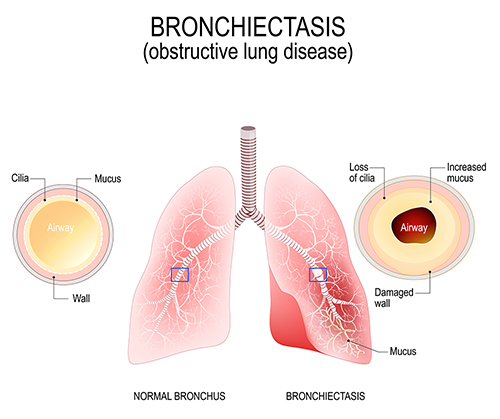Coping with Airway Mucus
Individuals with bronchiectasis and nontuberculous mycobacterial (NTM) lung disease struggle to keep their airways clear of mucus. Bronchiectasis causes too much mucus, which collects in the lungs. It also creates expanded airways, which makes it harder to cough up the mucus. The cilia in the airways also struggle to clear mucus from the lungs. Cilia are tiny, hair-like structures that help to “sweep” the mucus out of the smaller airways into larger airways. In bronchiectasis and NTM, the cilia are often damaged because of a thickening of the airway wall. All three of these problems cause mucus to collect in the lungs. When mucus collects in the lungs, it creates an ideal home for bacteria to live, grow and cause infections. This can lead to further inflammation and worsening of your condition. For these reasons, it is important for patients to create a bronchial hygiene routine to help clear mucus from the lungs. This will break the cycle of inflammation and infection.

Bronchial hygiene measures are those done on a routine basis to help clear the mucus from the lungs. If you have a chronic lung condition, it is very important that you find a bronchial hygiene routine that works best for you. Your pulmonologist can guide you in choosing the right routine for your diagnosis. Not every person with a chronic lung condition responds the same way to each routine. You may need to change your routine during different seasons, when you have a flare-up or exacerbation, or for other personal health reasons.
A typical bronchial hygiene routine uses therapy from one or more of the following categories1:
- Manual techniques for airway clearance – There are several different coughing and breathing methods that will help you move and cough up the mucus in your lungs. These methods should make your coughing more effective. These methods should also make coughing less irritating to your throat and less tiring. Click here to learn more about the different types of manual airway clearance techniques.
- Devices for airway clearance – Mucus can be sticky, which makes it even more difficult to move. Airway clearance devices can help loosen the mucus. This will allow it to move from the smaller airways into the larger airways, where it can be coughed out. You may need or want to use a device in your bronchial hygiene routine. Click here to learn more about different airway clearance devices.
- Medications for airway clearance – Your doctor may give you the names of over-the-counter medicines, prescription medicines, and inhaled therapies that can help make the mucus thinner. Thinner mucus is easier to cough up. Remember to follow their instructions carefully. Report any side effects that occur. Click here to learn more about different medicines that can help with airway clearance.
Regardless of the type of bronchial hygiene measure(s) you use, the most important thing to consider is—is it working effectively? Is it helping you cough out the mucus and clear your lungs? Doing so will help you lower your risk of infection and eliminate any airway blockage.2
References
1Lester M, Fume P. Airway-clearance therapy guidelines and implementation. Respir Care. 2009;54(6):733-753. doi: https://doi.org/10.4187/002013209790983205
2Lesan A, Lamle AE. Short review on the diagnosis and treatment of bronchiectasis. Med Pharm Rep. 2019;92(2):111-116. doi: https://doi.org/10.15386/cjmed-1060